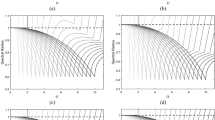Abstract
In this paper, a novel time-marching procedure is proposed for dynamic analysis. The proposed new technique is fourth-order accurate for undamped models; third-order accurate for numerically damped models; and second-order accurate for physically damped models. The method is very straightforward to implement and to apply, allowing providing higher-order accurate time-domain solutions taking into account basically the same computational effort of standard single-step first- or second-order accurate time-marching procedures. Numerical examples are presented at the end of the paper, illustrating the excellent accuracy of the novel approach.
















Similar content being viewed by others
References
Newmark NM (1959) A method of computation for structural dynamics. J Eng Mech Div ASCE 85:67–94
Hilber HM, Hughes TJR, Taylor RL (1977) Improved numerical dissipation for time integration algorithms in structural dynamics. Earthq Eng Struct Dyn 5:283–292
Wood WL, Bossak M, Zienkiewicz OC (1980) An alpha modification of Newmark’s method. Int J Numer Methods Eng 15:1562–1566
Chung J, Hulbert JM (1993) A time integration method for structural dynamics with improved numerical dissipation: the generalized α method. J Appl Mech 30:371–375
Hulbert GM, Chung J (1996) Explicit time integration algorithms for structural dynamics with optimal numerical dissipation. Comput Methods Appl Mech Eng 137:175–188
Mancuso M, Ubertini F (2001) Collocation methods with controllable dissipation for linear dynamics. Comput Methods Appl Mech Eng 190:3607–3621
Fung TC (2002) Higher-order accurate time-step-integration algorithms by post-integration techniques. Int J Numer Meth Eng 53:1175–1193
Bathe KJ, Baig MMI (2005) On a composite implicit time integration procedure for nonlinear dynamics. Comput Struct 83:2513–2534
Leontyev VA (2010) Direct time integration algorithm with controllable numerical dissipation for structural dynamics: two-step Lambda method. Appl Numer Math 60:277–292
Soares D (2011) A new family of time marching procedures based on Green’s function matrices. Comput Struct 89:266–276
Loureiro FS, Silva JEA, Mansur WJ (2015) An explicit time-stepping technique for elastic waves under concepts of Green’s functions computed locally by the FEM. Eng Anal Bound Elem 50:381–394
Soares D (2015) A simple and effective new family of time marching procedures for dynamics. Comput Methods Appl Mech Eng 283:1138–1166
Soares D (2016) A novel family of explicit time marching techniques for structural dynamics and wave propagation. Comput Methods Appl Mech Eng 311:838–855
Wen WB, Tao Y, Duan SY, Yan J, Wei K, Fang DN (2017) A comparative study of three composite implicit schemes on structural dynamic and wave propagation analysis. Comput Struct 190:126–149
Soares D (2019) A model/solution-adaptive explicit-implicit time-marching technique for wave propagation analysis. Int J Numer Methods Eng 119:590–617
Soares D (2019) An adaptive semi-explicit/explicit time marching technique for nonlinear dynamics. Comput Methods Appl Mech Eng 354:637–662
Zhang HM, Xing YF (2019) Two novel explicit time integration methods based on displacement–velocity relations for structural dynamics. Comput Struct 221:127–141
Kim W (2019) An accurate two-stage explicit time integration scheme for structural dynamics and various dynamic problems. Int J Numer Methods Eng 120:1–28
Soares D (2020) A novel time-marching formulation for wave propagation analysis: the adaptive hybrid explicit method. Comput Methods Appl Mech Eng 366:113095
Fung TC (1999) Weighting parameters for unconditionally stable higher-order accurate time step integration algorithms. Part 2: second-order equations. Int J Numer Methods Eng 45:971–1006
Fung TC (2001) Solving initial value problems by differential quadrature method—Part 2: second-and higher-order equations. Int J Numer Methods Eng 50:1429–1454
Kim W, Reddy JN (2017) A new family of higher-order time integration algorithms for the analysis of structural dynamics. J Appl Mech 84:071008
Huang C, Fu MH (2018) A composite collocation method with low-period elongation for structural dynamics problems. Comput Struct 195:74–84
Hughes TJR (2000) The finite element method: linear static and dynamic finite element analysis. Dover Publications INC., New York
Clough RW, Penzien J (1995) Dynamics of structures. Computers and Structures Inc., Berkeley
Acknowledgements
The financial support by CNPq (Conselho Nacional de Desenvolvimento Científico e Tecnológico) is greatly acknowledged.
Author information
Authors and Affiliations
Corresponding author
Additional information
Publisher's Note
Springer Nature remains neutral with regard to jurisdictional claims in published maps and institutional affiliations.
Rights and permissions
About this article
Cite this article
Soares, D. A straightforward high-order accurate time-marching procedure for dynamic analyses. Engineering with Computers 38, 1659–1677 (2022). https://doi.org/10.1007/s00366-020-01129-1
Received:
Accepted:
Published:
Issue Date:
DOI: https://doi.org/10.1007/s00366-020-01129-1




